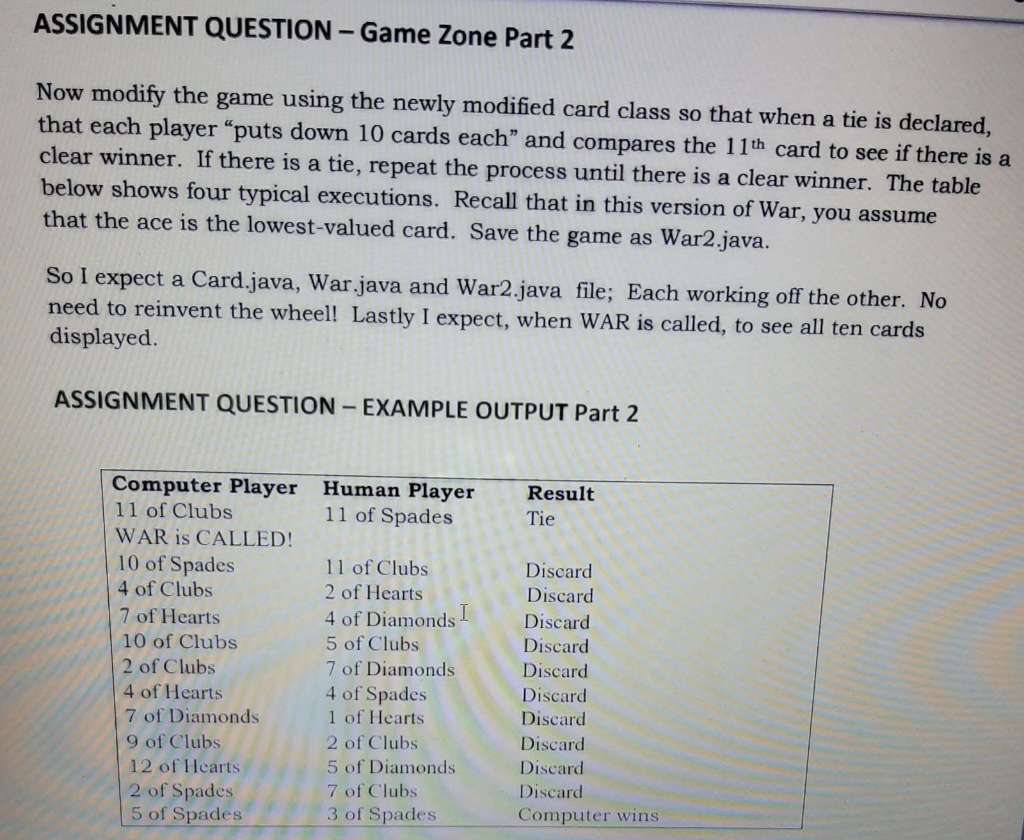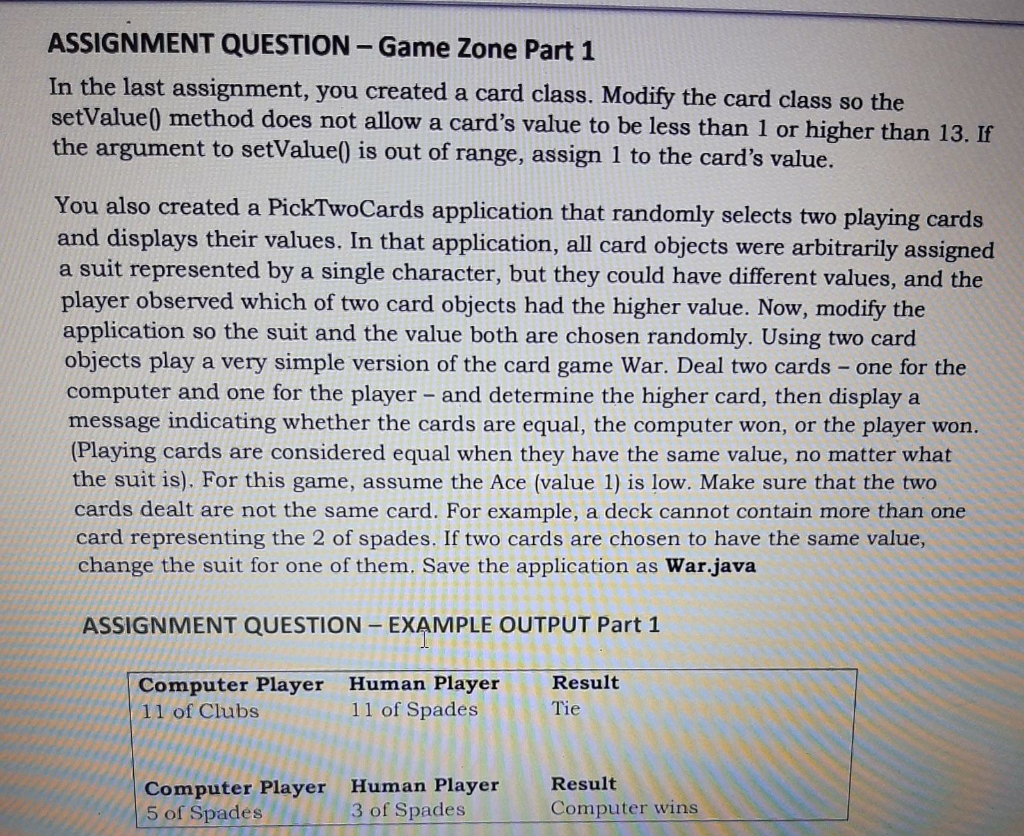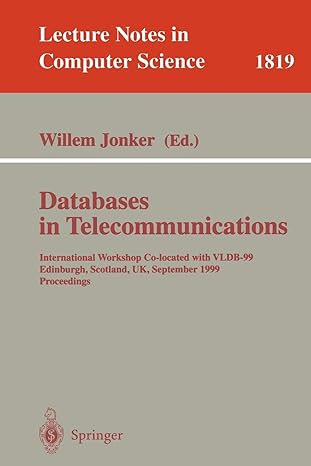Question
i need help with both questions IMPORTANT-ASSIGNMENT DONE OVER with only two lines of code in the main method. Game Zone Part 1 In the

 i need help with both questions
i need help with both questions
IMPORTANT-ASSIGNMENT DONE OVER with only two lines of code in the main method.
Game Zone Part 1 In the last assignment, you created a card class. Modify the card class so the setValue() method does not allow a cards value to be less than 1 or higher than 13. If the argument to setValue() is out of range, assign 1 to the cards value. You also created a PickTwoCards application that randomly selects two playing cards and displays their values. In that application, all card objects were arbitrarily assigned a suit represented by a single character, but they could have different values, and the player observed which of two card objects had the higher value. Now, modify the application so the suit and the value both are chosen randomly. Using two card objects play a very simple version of the card game War. Deal two cards one for the computer and one for the player and determine the higher card, then display a message indicating whether the cards are equal, the computer won, or the player won. (Playing cards are considered equal when they have the same value, no matter what the suit is). For this game, assume the Ace (value 1) is low. Make sure that the two cards dealt are not the same card. For example, a deck cannot contain more than one card representing the 2 of spades. If two cards are chosen to have the same value, change the suit for one of them. Save the application as War.java *****************************************************************************
Game Zone Part 2 Now modify the game using the newly modified card class so that when a tie is declared, that each player puts down 10 cards each and compares the 11th card to see if there is a clear winner. If there is a tie, repeat the process until there is a clear winner. The table below shows four typical executions. Recall that in this version of War, you assume that the ace is the lowest-valued card. Save the game as War2.java. So I expect a Card.java, War.java and War2.java file; Each working off the other. No need to reinvent the wheel! Lastly I expect, when WAR is called, to see all ten cards displayed. ************************************************** Result should look like what is below)***** ************************************************** Computer Player Human Player Result 11 of Clubs 11 of Spades Tie WAR is CALLED! 10 of Spades 11 of Clubs Discard 4 of Clubs 2 of Hearts Discard 7 of Hearts 4 of Diamonds Discard 10 of Clubs 5 of Clubs Discard 2 of Clubs 7 of Diamonds Discard 4 of Hearts 4 of Spades Discard 7 of Diamonds 1 of Hearts Discard 9 of Clubs 2 of Clubs Discard 12 of Hearts 5 of Diamonds Discard 2 of Spades 7 of Clubs Discard 5 of Spades 3 of Spades Computer wins
ASSIGNMENT QUESTION - Game Zone Part 2 Now modify the game using the newly modified card class so that when a tie is declared, that each player puts down 10 cards each and compares the 11th card to see if there is a clear winner. If there is a tie, repeat the process until there is a clear winner. The table below shows four typical executions. Recall that in this version of War, you assume that the ace is the lowest-valued card. Save the game as War2.java. So I expect a Card.java, War.java and War2.java file; Each working off the other. No need to reinvent the wheel! Lastly I expect, when WAR is called, to see all ten cards displayed. ASSIGNMENT QUESTION - EXAMPLE OUTPUT Part 2 Result Tie Computer Player Human Player | 11 of Clubs 11 of Spades WAR is CALLED! 10 of Spades 11 of Clubs 4 of Clubs 2 of Hearts 7 of Hearts 4 of Diamonds 10 of Clubs 5 of Clubs 2 of Clubs 7 of Diamonds 4 of Hearts 4 of Spades 7 of Diamonds 1 of Hearts 9 of Clubs 2 of Clubs 12 of Hearts 5 of Diamonds 2 of Spades 7 of Clubs 5 of Spades 3 of Spades Discard Discard Discard Discard Discard Discard Discard Discard Discard Discard Computer wins ASSIGNMENT QUESTION - Game Zone Part 1 In the last assignment, you created a card class. Modify the card class so the setValue() method does not allow a card's value to be less than 1 or higher than 13. If the argument to setValue() is out of range, assign 1 to the card's value. You also created a PickTwoCards application that randomly selects two playing cards and displays their values. In that application, all card objects were arbitrarily assigned a suit represented by a single character, but they could have different values, and the player observed which of two card objects had the higher value. Now, modify the application so the suit and the value both are chosen randomly. Using two card objects play a very simple version of the card game War. Deal two cards - one for the computer and one for the player - and determine the higher card, then display a message indicating whether the cards are equal, the computer won, or the player won. (Playing cards are considered equal when they have the same value, no matter what the suit is). For this game, assume the Ace (value 1) is low. Make sure that the two cards dealt are not the same card. For example, a deck cannot contain more than one card representing the 2 of spades. If two cards are chosen to have the same value, change the suit for one of them. Save the application as War.java ASSIGNMENT QUESTION - EXAMPLE OUTPUT Part Result Computer Player Human Player 11 of Clubs 11 of Spades of Spades Tie Computer Player Human Player 5 of Spades 3 of Spades Result Computer winsStep by Step Solution
There are 3 Steps involved in it
Step: 1

Get Instant Access to Expert-Tailored Solutions
See step-by-step solutions with expert insights and AI powered tools for academic success
Step: 2

Step: 3

Ace Your Homework with AI
Get the answers you need in no time with our AI-driven, step-by-step assistance
Get Started


